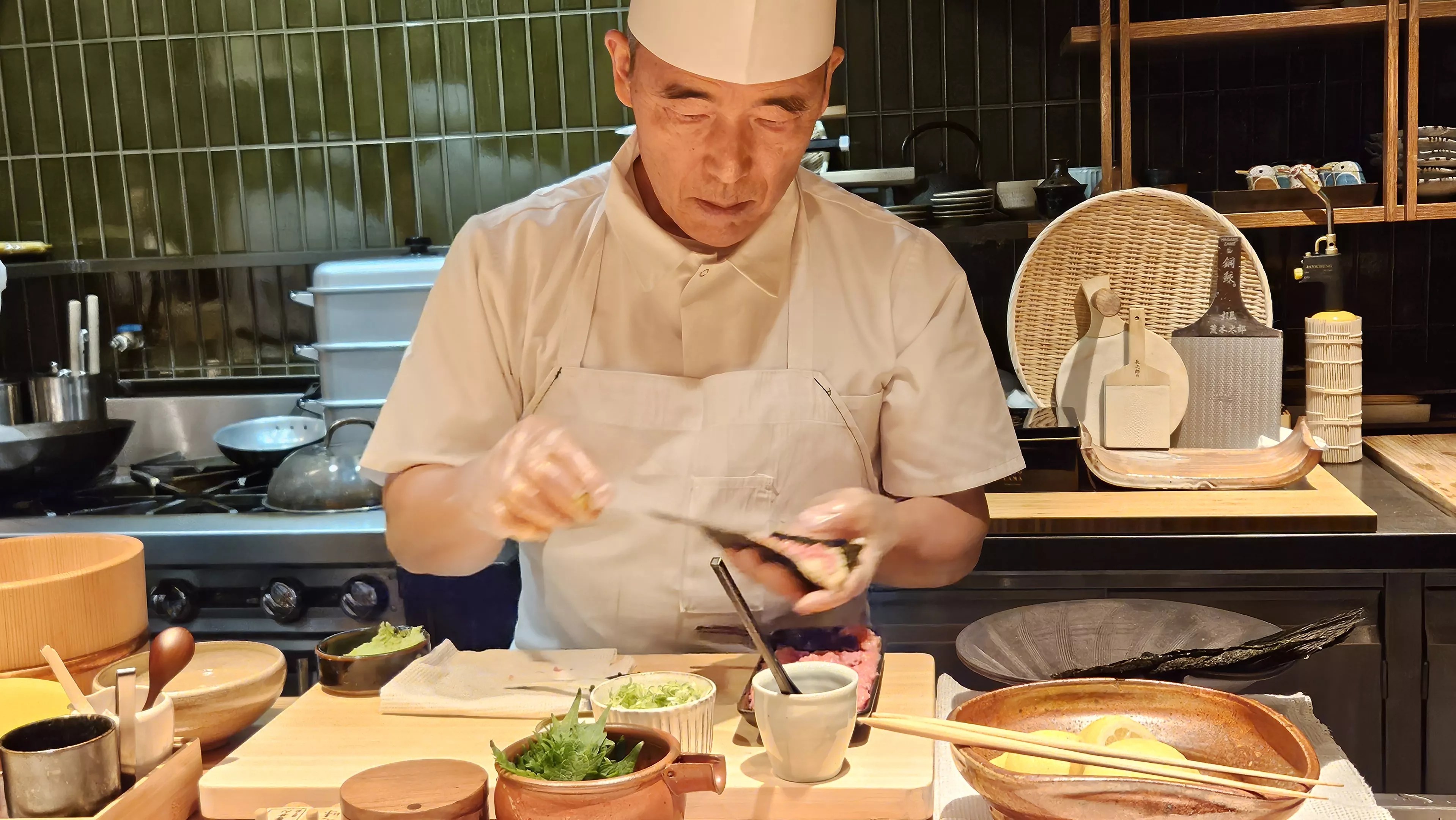
Gil Asakawa

Audio By Carbonatix
Just a few decades ago, sushi was a rare and exotic treat. While the Japanese concept was familiar on the coasts by the late 1960s, only a couple of Denver restaurants were serving sushi by the 1990s. Sushi-Rama, which closed this year, was the first conveyor belt sushi in Denver when it opened in 2015. Matsuhisa, a world-famous sushi brand started by chef Nobu Matsuhisa, opened in 2016 in Cherry Creek, and it was big news.
But today, sushi has exploded, and you can even pick up a tray at the supermarket. Not too exotic anymore.
But one form of the sushi dining experience is still rare: omakase, where the sushi selection is left up to the chef, and fairly spontaneous. Given that level of attention, these dinners are expensive – but not as rare as you might think. Denver’s omakase dinners range from $150 to $225 for an hour-and-a-half to two-hour session, depending on how many courses are served and how many diners are at the counter.
Like bartenders, the chefs behind the sushi bar craft the individual pieces to place on each plate, choosing the lineup from available ingredients and customer preferences (as well as their own) and explaining each dish. Diners are urged to eat the sushi in one bite as the plates are placed in front of them, always using their fingers.
Denver, make your New Year’s Resolution Count!
We’re $12,000 away from reaching our $50,000 year-end fundraising goal. Your support could be what pushes us over the top. If our work has kept you informed and connected this year, please consider making a contribution today.
In Denver, omakase and kaiseki are often used interchangeably to describe these dining experiences. While omakase translates to “leave it to me,” and often reflects a chef’s improvisational skills, kaiseki is defined more broadly as “multi-course meal,” one that’s carefully curated in advance.
But no matter which term a Denver restaurant uses, the result is usually over the top, as I discovered when I was treated to four amazing omakase/kaiseki meals over the past few weeks.
Omakase with a taste of Laos
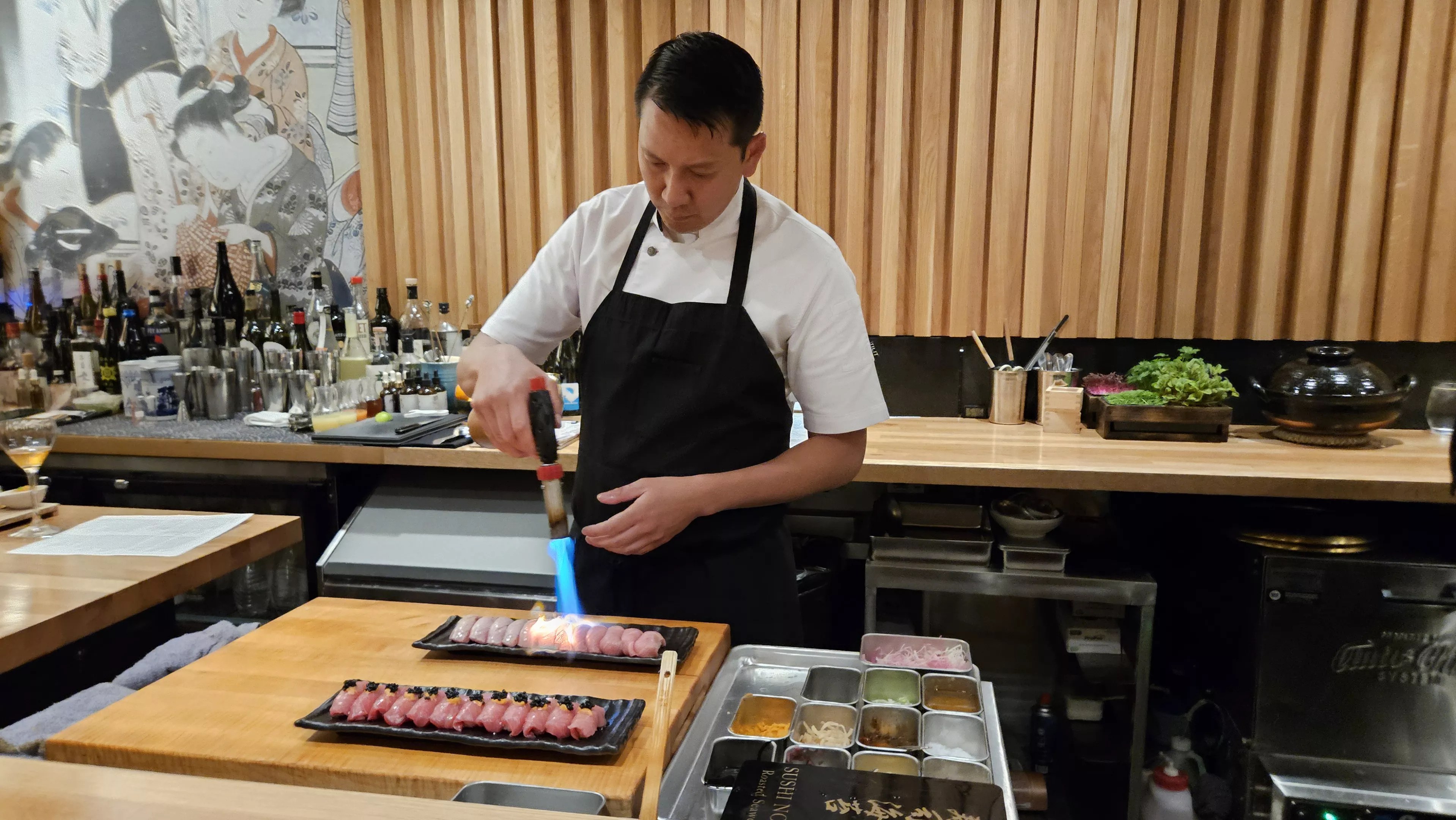
Ukiyo’s chef Phraseuth “Paul” Sananikone celebrates his Lao heritage while serving excellent Japanese sushi.
Gil Asakawa
My first meal in this omakase extravaganza was at Ukiyo, the small, beautiful downstairs bar beneath Bao Brewhouse, around the corner from Larimer Square. The sushi master here is chef Phraseuth “Paul” Sananikone, a Lao-American raised in Texas who was introduced to Japanese cuisine at his parents’ hibachi grill restaurant.
Like the conductor of a chamber orchestra (with some of the musicians in the kitchen behind the wall), Sananikone led his crew in prepping each course while serving diners’ every need. (Beverage manager Jeremiah Watson was a veritable encyclopedia of wine and spirits, as well as drinks.) Sananikone lets his staff of chefs do most of the explaining; his great talent is his ability to seamlessly incorporate Laotian culture into the food he serves.
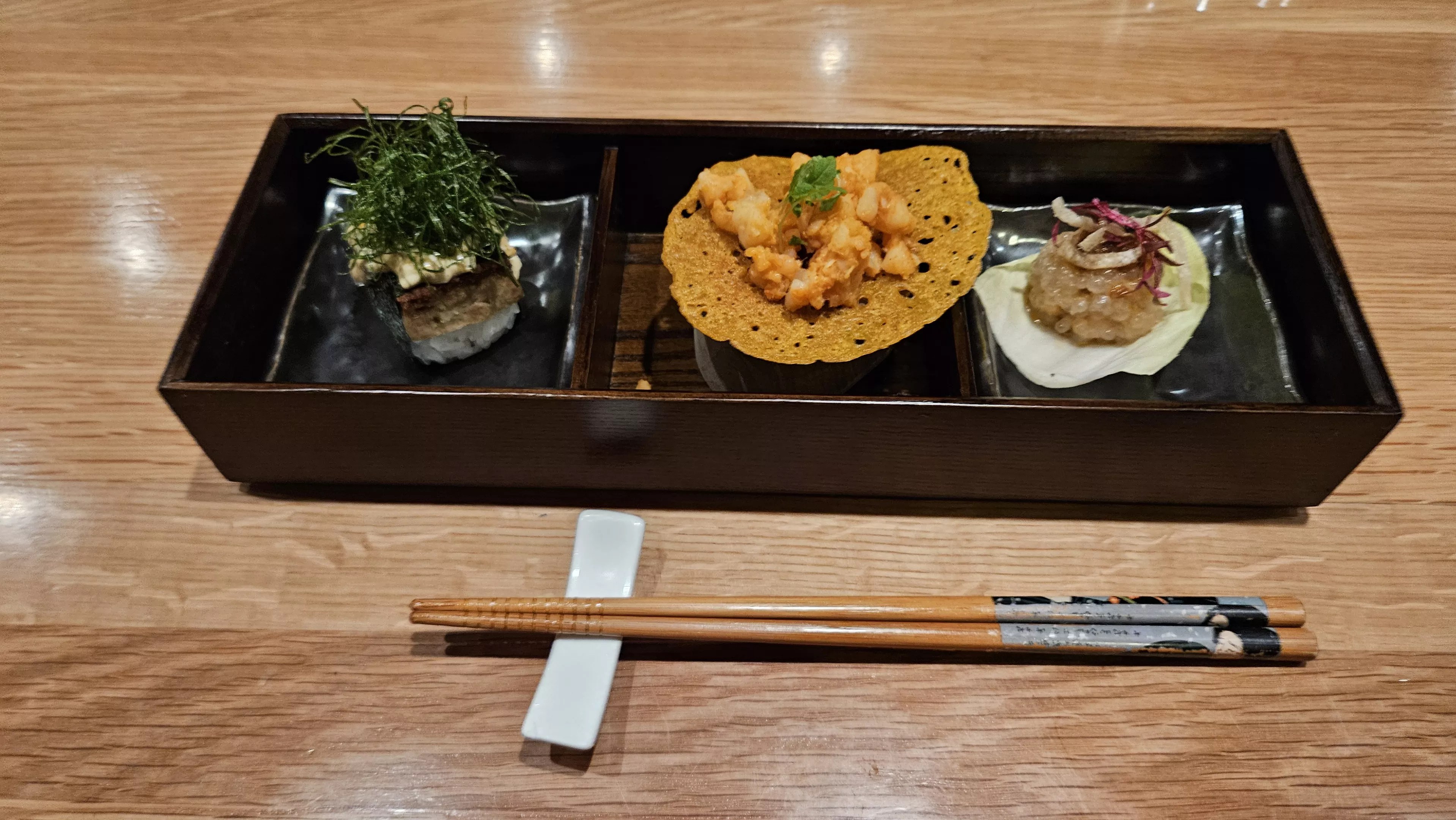
Ukiyo Bento Trio appetizer with Bahn Xeo Tuile and Shrimp, Lao Spam Musubi with Gel Bong Aioli, Sakoo and Purple Cabbage.
Gil Asakawa
One of the first dishes was a “bento box” with three small compartments that contained a Lao Spam musubi with Southeast Asian aioli, a turmeric cracker with sauteed shrimp Sakoo Thai, and a Lao tapioca pork dumpling. While many of his presentations were more familiar to sushi fans, they all had a Lao flair, adding an indelible piece of heritage and history.
Omakase served at a table, kaiseki-style
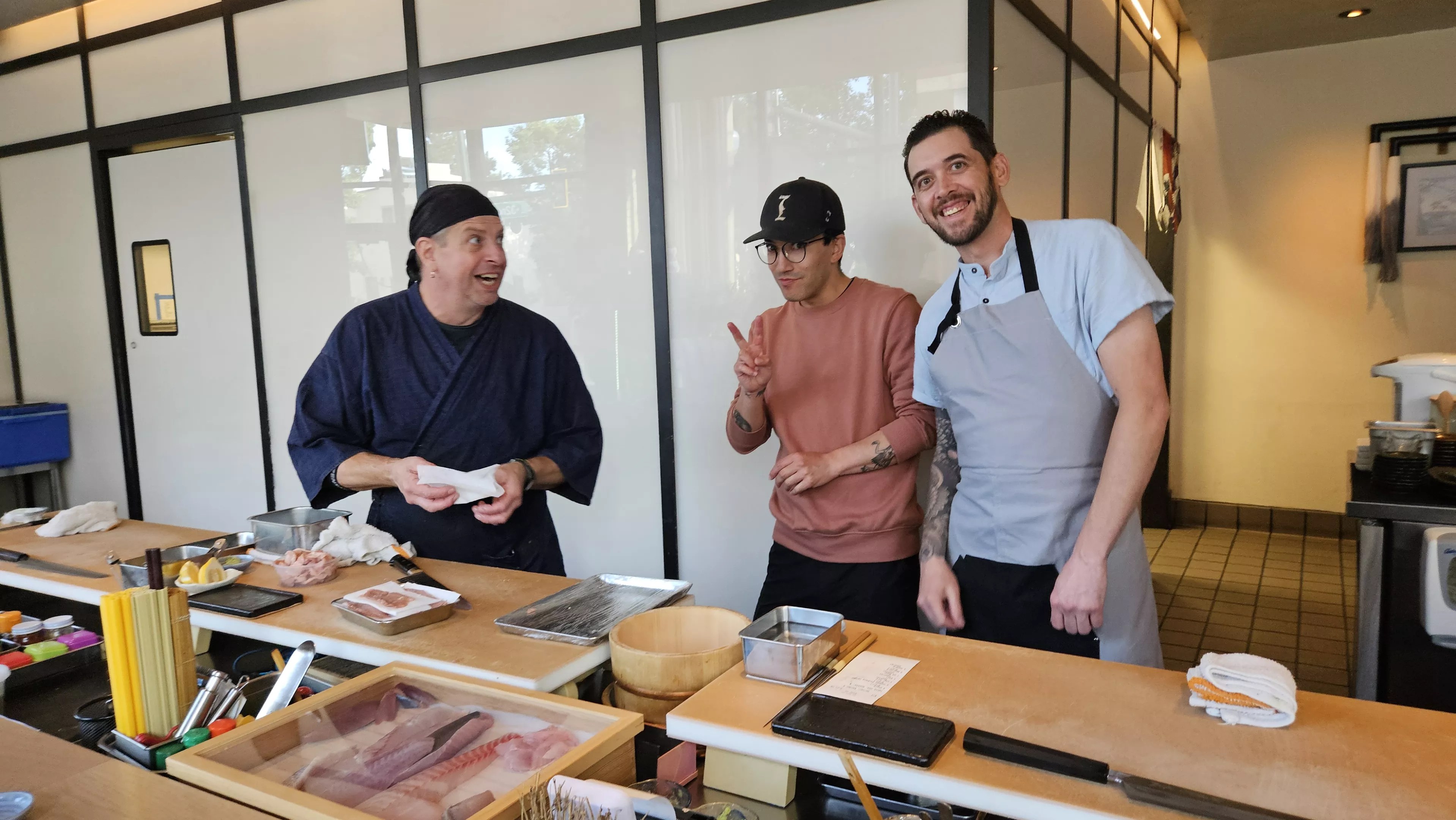
Chef Corey Baker (right) and his team create the sushi at Kumoya.
Gil Asakawa
Next up, I attended a lavish media dinner hosted by InKind, a dining app featuring eateries around the world that offer discounts and deals; you pay with the app to get cash-back bonuses as you would with credit cards or airline mileage programs. InKind held this dinner at Kumoya in the Highland neighborhood, where chef Corey Baker led the trio of sushi chefs. This posh spot (the attached Bar Kumo gets jumping later in the evening) has a small sushi bar with counter seating, but instead of that traditional omakase setting, our meal was served at tables in a side room, with the bites coming on long ceramic trays. Wagyu beef, one of the omakase offerings at at Kumoya. Gil Asakawa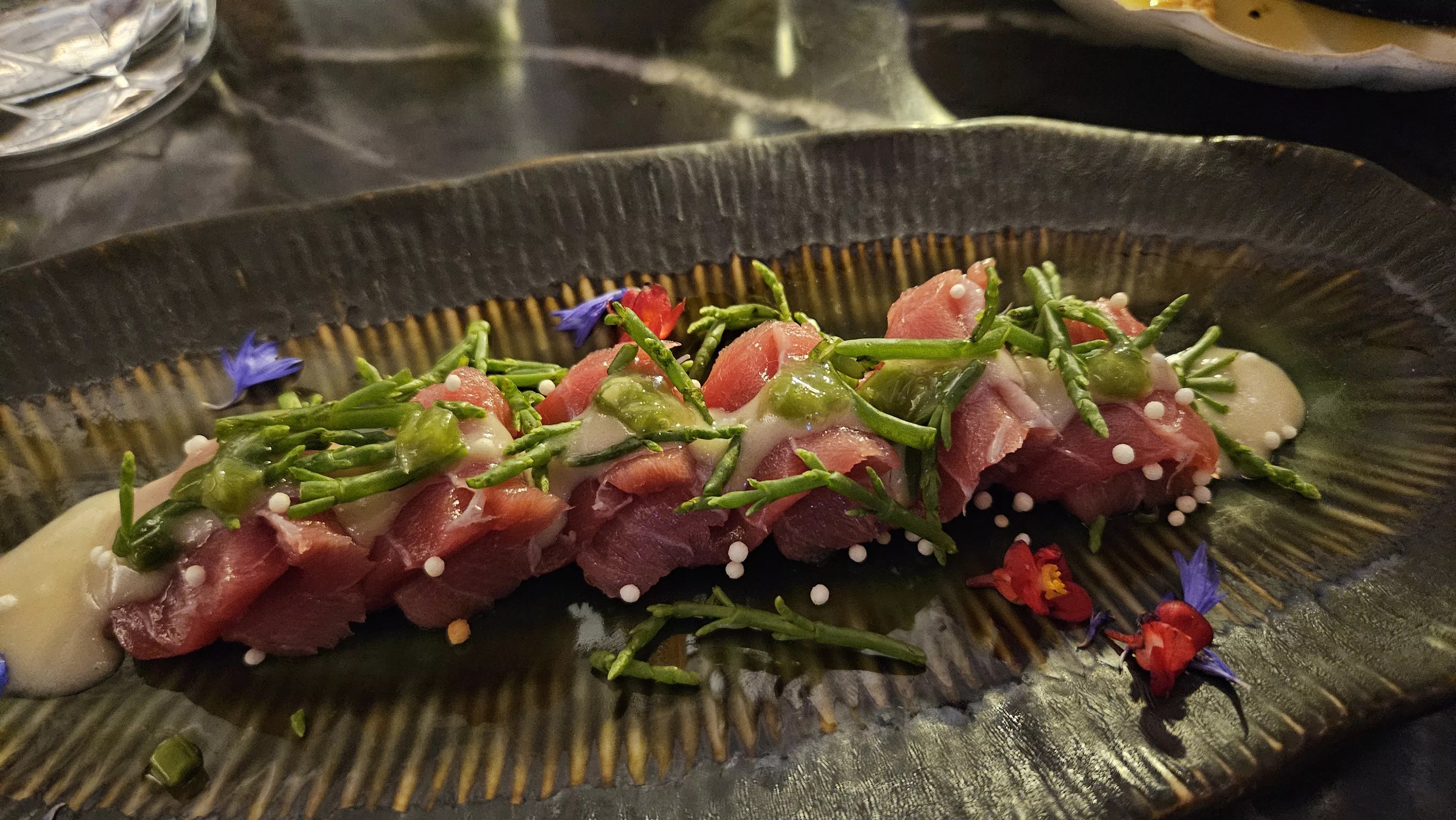
The food was spectacular and presented with artistry, even though the courses weren’t individual bites. Although I had mocktails, the rest of the table enjoyed a free flow of many sakes, wines and spirits – some pretty pricey. We all had a great time, but I’m eager to go back when I’m a regular customer, not part of a prebooked group.
Served by the OG of Denver omakase
Denver’s sushi community acknowledges that Toshi Kizaki is the OG of local omakase. When other sushi chefs call him that, they say it with respect; he helped introduce and educate Denver to the joys of sushi in all its traditional forms. Toshi and his brother Yasu opened Sushi Den in the Platt Park neighborhood on Christmas Eve 1984; while other Denver restaurants served sushi before that, the Kizaki brothers’ entrepreneurial determination to serve the best sushi (flown in daily from the fish markets of Japan) in the city ultimately led to an empire of businesses, including several eateries along the same stretch of South Pearl Street. A display of available ingredients for the evening, chilling on an ice sculpture. Gil Asakawa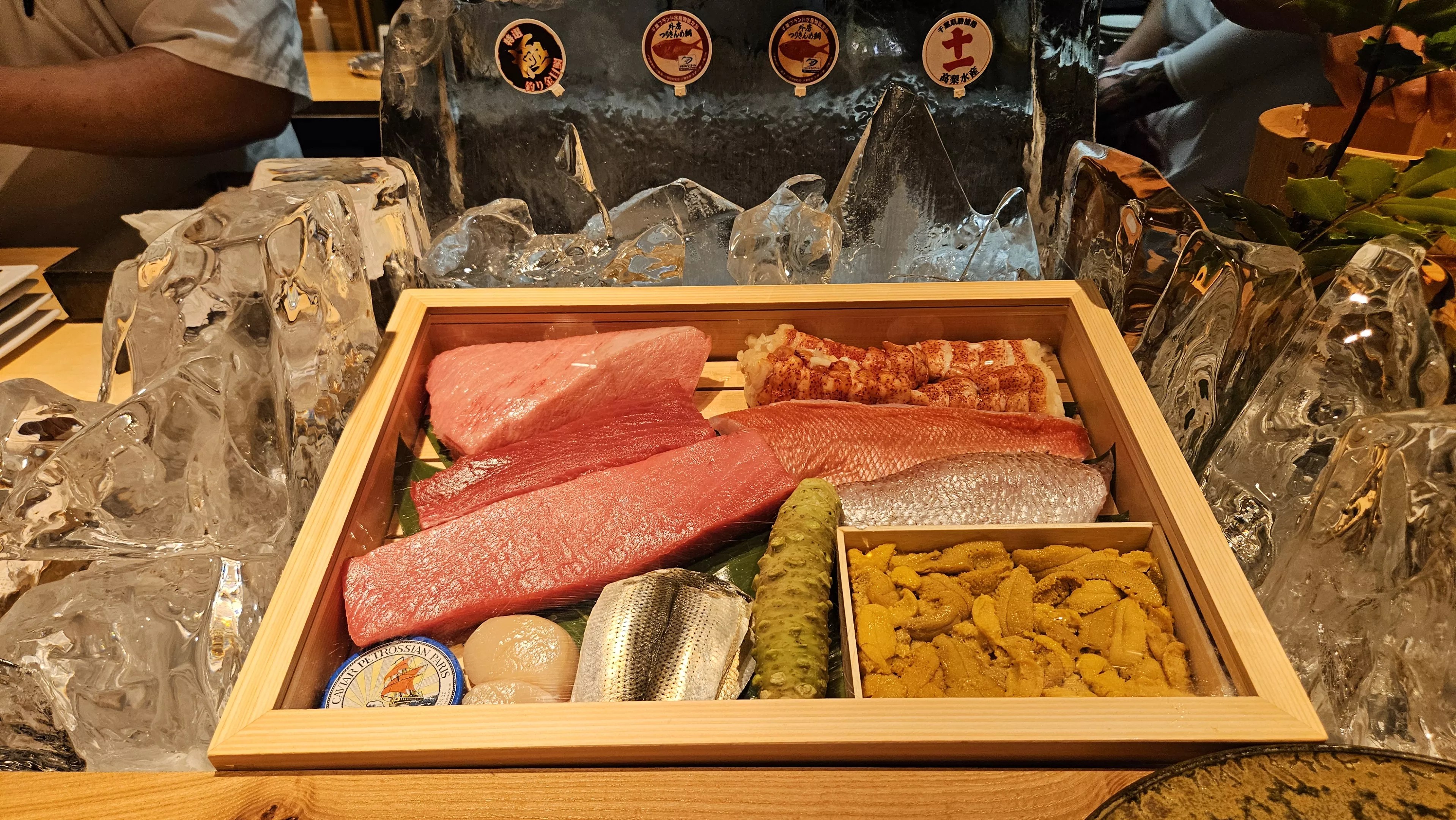
Kizaki is Toshi’s latest restaurant, which he only half-jokingly calls his “retirement” spot. It’s a small omakase room with an overflow of tables where servers take his creations to diners who can’t all fit around the sushi bar. In the center of that bar is a display case with some of the fresh catch he’ll work with, chilling on a striking ice sculpture that looks like the craggy Rocky Mountains. New Zealand King Salmon Nigiri topped with Ikura salmon roe at Kizaki. Gil Asakawa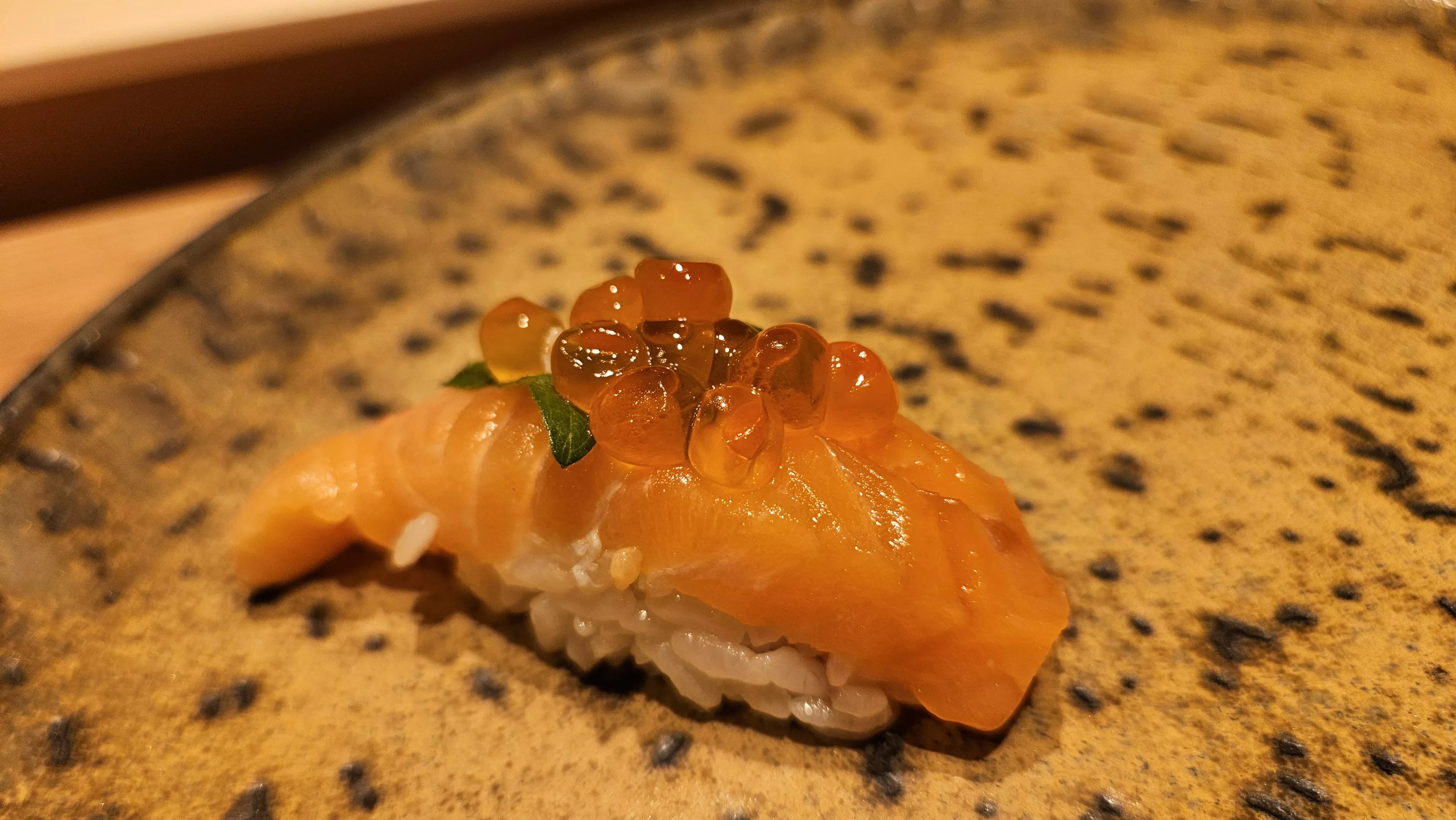
Toshi serves traditional, Edo-mae sushi the way the original masters in Edo (the old name for Tokyo) made sushi as a handheld street food at yatai, or carts stocked with the freshest fish available. During my night at Kizaki, his presentation was immaculate, precise and no-nonsense. A little splash of color and salty taste from ikura salmon roe and a few slices of negi green onion were all the modern touches needed to bring your tastebuds into the 21st century.
While Kizaki is a new restaurant, Toshi points out that he was the first to implement a chef-driven omakase experience at Sushi Den, back in the restaurant’s early days. It wasn’t called omakase or priced accordingly – but if you sat the counter, chef Toshi would serve you whatever he decided were the best bites that night.
Bagels by day, omakase by night
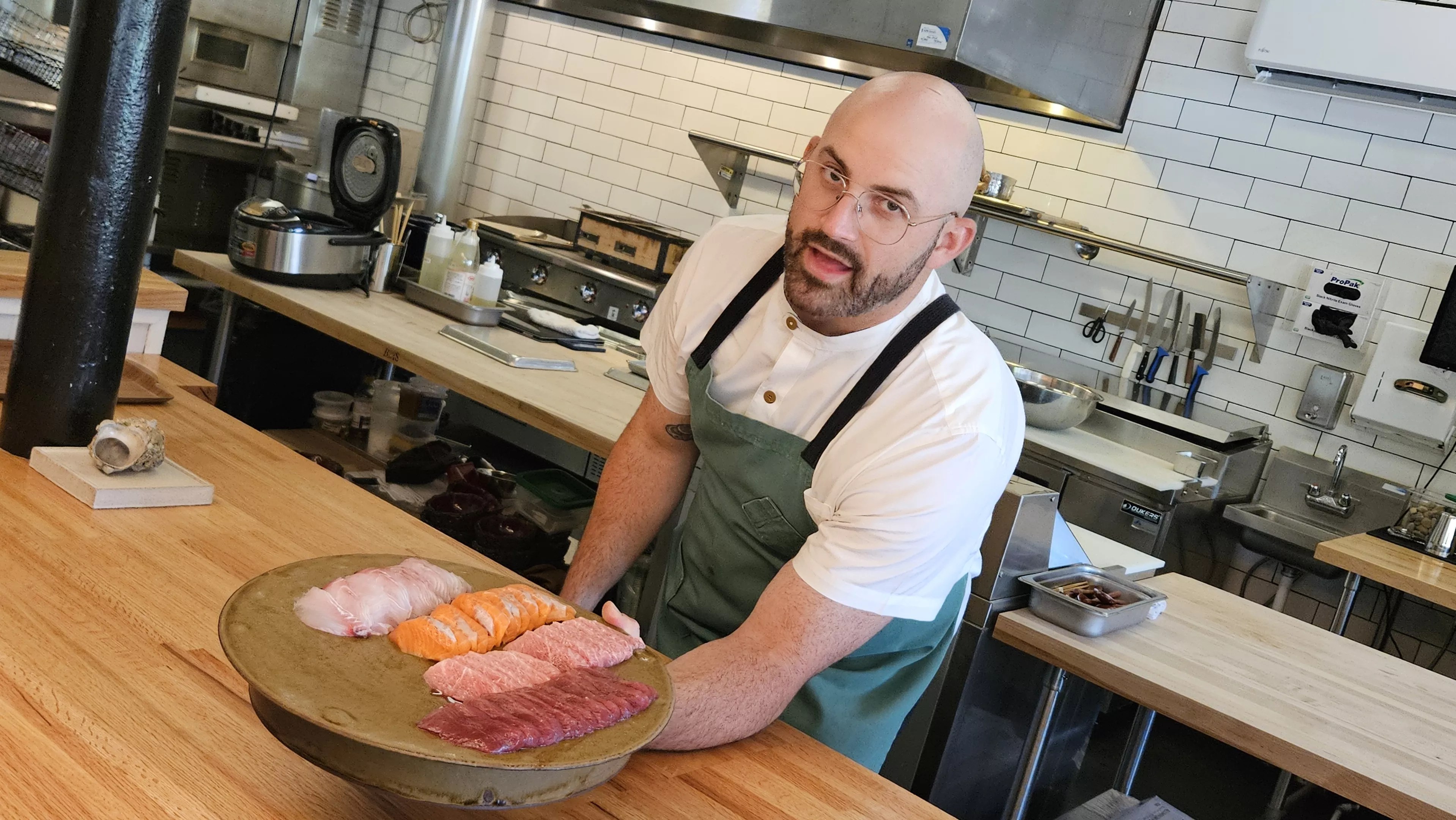
Chef Miles Odell showing diners the fish that will be used in the sushi portion of the menu.
Gil Asakawa
Chef Miles Odell brings a different twist to his omakase restaurant, yet he’s as anchored in sushi traditions as is Toshi-san. Odell grew up in New Jersey and fell in love with Japanese food at an early age; he knew he wanted to work in restaurants even as a kid. He studied at the French Culinary Institute and, as a young man, he was driven enough – and good enough – to get hired at Michelin-starred restaurants. While still in his twenties, he was chosen to be one of just fifteen chefs from around the world to go to Japan for a one-year training program that placed him in a Kyoto kaiseki restaurant, where he learned the minutiae of operating, cooking and serving the most traditional of Japanese cuisines. He extended his stay for a couple of years to soak up more Japanese cooking, then returned to the U.S., eventually making his way to Denver after falling in love with Colorado on vacation. Starter at The Counter at Odell’s — Zensai appetizers of Tofu Beets, Milk Toast with fish and fish roe, and Sazae sea snails. Gil Asakawa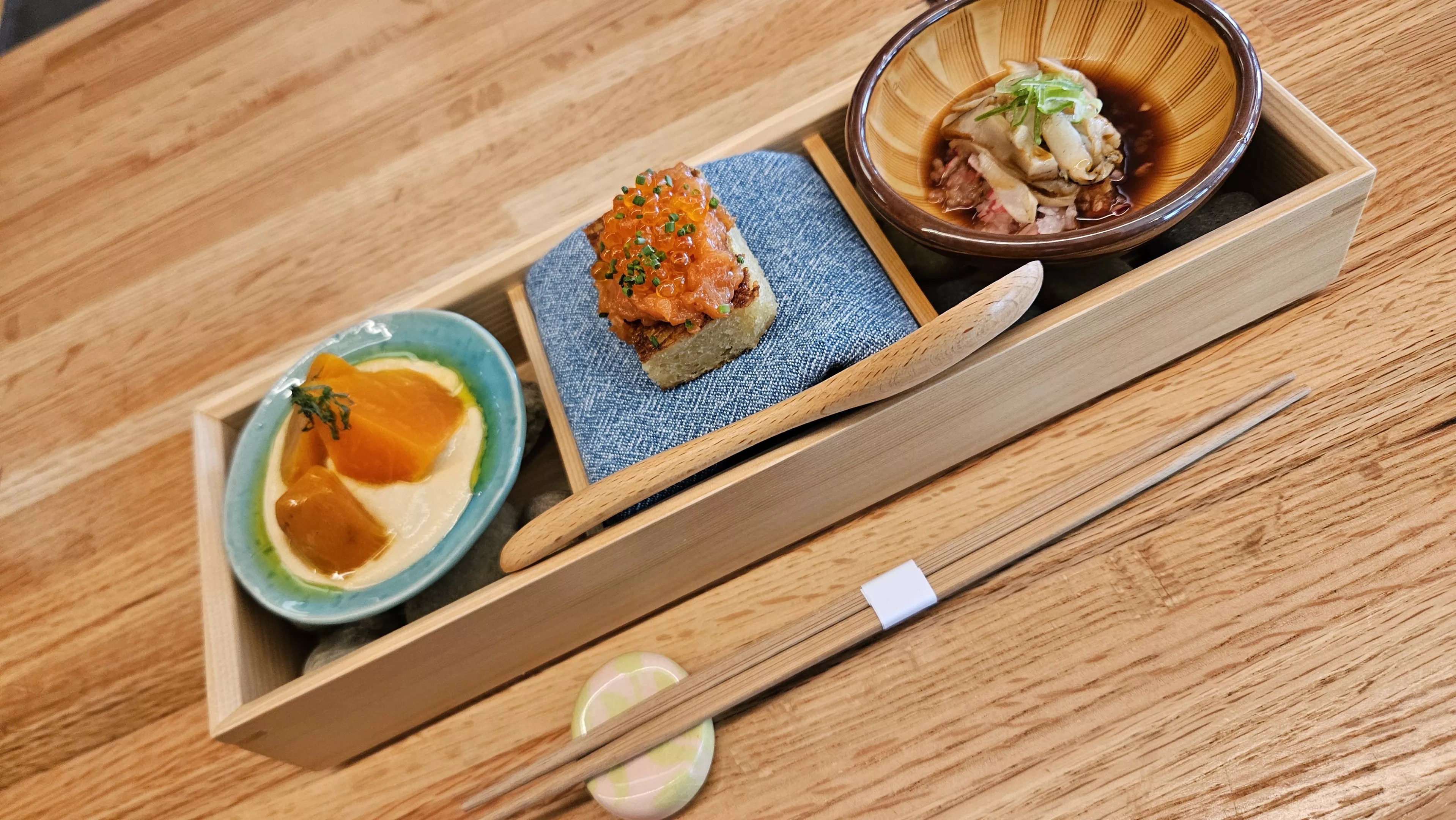
He always wanted to open a Japanese restaurant where he could showcase everything he’d learned and everything he loved. But he decided that what Denver really needed first wasn’t another top Japanese restaurant, but … a bagel shop. He opened Odell’s Bagel in Highland late last year, and then added The Counter at Odell’s this spring. His restaurant is a clean, bright space with a huge kitchen compared to that of typical sushi bars, in order to accommodate the hundreds of bagels that go out the door every morning.
But at night, Odell is all Japanese.
My evening at Odell’s was full of information about Japanese food, served kaiseki style. “I truly think the word ‘omakase’ is misappropriated in America,” says Odell. “I never have called myself an omakase restaurant, but that being said, a large portion of our menu is sushi. But the dishes around it are very much geared toward seasonality and what ingredients are available to us – and for me, that’s a very kaiseki kind of mentality, right?
“For instance, this week we have iwashi (sardine) on our menu. And it’s really hard to find that in Denver, but we finally got a good iwashi, so we wanted to serve it. More than half of our nigiri portion of the menu changes every week. That’s maybe more omakase (in spirit), but it’s a set menu. It’s printed. So I didn’t want to call our sushi omakase, because we’re definitely a kaiseki-inspired tasting menu.”
But whatever you called it, it was delicious.
In fact, all four dinners were excellent…and worth it. Yes, it’s expensive to go out for this level of cuisine and customer service, but the fact that so many diners are willing to do so reflects Denver’s continued growth as a food town.
Ukiyo is in the basement of Bao Brewhouse at 1317 14th Street, and open from 5:45 to 11 p.m. Tuesdays through Thursdays, and 5 p.m. to midnight Fridays and Saturdays; ukiyoomakase.com.
Kumoya is at 2400 West 32nd Avenue, and open from 5 to midnight Sunday through Thursday, and 5 p.m. to 2 a.m. Friday and Saturday; kumoyadenver.com.
Kizaki is at 1551 South Pearl Street, and open from 5 p.m. to midnight Wednesdays, and 5 to 10:30 a.m. Thursday through Saturday; denchukizaki.com.
The Counter at Odell’s is at 3200 Irving Street and open Friday through Sunday for two seatings nightly; reservations at Tock.